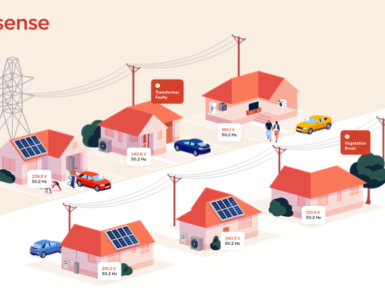
Michael Jary, Managing Director EMEA & APAC for Sense, discusses his top four 2024 predictions for the UK energy sector.
1. 2024 will see AI transform household energy consumption across the world; the UK must keep up
Electricity customers face a 5% increase to their bill from January 2024. High energy prices are creating huge uncertainty. At the same time, the energy transition and net zero demands increased electrification, for example the rise in electrification of heat and adoption of EVs, alongside increased integration of renewable sources.
All this means the way in which households and operators manage energy consumption must change. So, what’s the solution? Across the world there is increasing recognition that AI – in particular, AI-enabled smart meters – has a transformative role to play.
In the US households and operators are already experiencing the benefits of AI at the grid edge, through next-generation smart meters. AI-enabled smart meters go beyond the limitations of previous-generation meters. These advanced devices use machine learning and Real-Time Load Disaggregation (RTLD) to provide immediate, appliance-level insights into energy consumption. They are crucial for managing home energy consumption, especially with the increase of electric vehicles, heat pumps, and solar panels. Today’s transformative technologies can deliver the smart grid of tomorrow.
Next year represents a crucial turning point for the UK in ensuring its future energy infrastructure reaps the benefits of AI, for households, retailers, operators and the environment. In 2024, the UK has an opportunity to invest in AI to transform household energy; lowering costs, enabling crucial flexibility initiatives, such as domestic demand response, supporting enhanced grid stability. As such, the UK energy retailers, operators, and smart meter manufacturers need to future-proof smart meters today. Without this, the UK will fall behind in the race to deliver a clean, affordable and flexible energy system fit for the future.
2. Convincing consumers to embrace the smart meter deployment will become a priority
With a deadline of 2024 for retailers to install domestic meters, energy retailers must convince consumers of their benefits. According to an October report from the public accounts committee, they have so far failed to do so, jeopardising roll-out targets and leading to fines from Ofgem. Energy retailers now have until 2025 to install smart meters in 75% of homes. That means 2024 is a crucial moment to secure consumer buy-in.
Up until now the implementation of smart meters in the UK has left many consumers sceptical about the direct benefits they offer, such as cost savings and energy efficiency gains. To unlock the potential of smart meters, it is crucial to actively engage consumers and encourage their interaction with the data and insights provided by the meters.
The next year represents a turning point. With AI technologies delivering true, real-time insight into household energy use, energy retailers have an unprecedented opportunity to engage customers in the rollout. These AI-ready smart meters have the potential to lower customer bills and deliver the impact households have been promised. With high-resolution data and the ability to identify consumption down to individual devices, smart meters will finally be able to deliver on the promise made to consumers.
In North America and beyond, AI-ready, next-gen smart meters are already being specified in most new rollouts. However, in the UK previous generation meters are still being deployed and will be serving households for at least the next 20 years. In 2045 households reliant on these older meters will be reliant on technology designed in the 1990s and the early 2000s. It simply won’t be fit for purpose; akin to expecting a Nokia 8210 to stand up in a world of next-generation iPhones.
As the UK smart meter rollout gains momentum, it is key that the right technological decisions are made right now. That means future-proofing smart meter technology today with software-driven, AI-integrations so that it keeps pace with the demands of our data-driven world, delivering real benefits for decades to come.
3. Demand flexibility will drive the UK’s energy transition
Over the next year, demand flexibility (DF) programmes will become a core strand of the UK’s energy transition. Last winter’s successful Demand Flexibility Service, run by National Grid ESO, delivered a significant reduction in energy use. Demand response events use real-time cooperation between energy suppliers and consumers to ensure a balanced and efficient grid during times of increased demand. In 2024 and beyond, demand response events like this will become commonplace.
However, rolling out these schemes at scale will require both engaged consumers and real-time communication with the household. To ensure more households become active participants in DF events, it is essential they have instant insight into energy consumption at an appliance level and a simple way to contribute to DF programmes. This is where next-generation smart meters empowered by AI technologies come into their own. By providing real time, appliance level nudges to consumers, AI technologies enable more efficient demand response and more effective time-of-use tariffs.
As the UK continues its journey towards net zero, Demand Response programmes must play a pivotal role. Technology is at the heart of this. With the right technologies, including AI, widespread use of DF strategies is not an ambition for the future. With the right technologies and tools, it is now a workable, scalable strategy for today.
4. Real-time made real; energy tech will finally close the 15-minute data gap
As consumers, we are living in a world where acting on real-time feedback and data is part of everyday life. We are accustomed to using real-time data for our benefit, such as fitness trackers monitoring our heart rate or live traffic information on our phones. However, when considering household energy use, a lack of real-time insight has left consumers in the dark.
Until now, smart meters have been considered as devices that count, primarily used for billing purposes. First generation smart meters rely on (at best) 15-minute interval data, which can be delayed for up to 24 hours before consumers access it. This delay decreases engagement, stifles the ability for households to take meaningful action on consumption and poses challenges for utilities. However, it’s the ability to process consumption information in true, real time at the edge that enables consumers to make the right decisions and for operators to make instantly impactful decisions.
By harnessing advanced AI and machine learning real-time monitoring systems, with second-by-second data, users are empowered to optimise energy efficiency, make informed decisions, and reduce energy bills. With consumers playing a crucial role in the energy transition it is vital to provide the real-time experience they enjoy elsewhere here too.
Additionally, this real-time data enables energy retailers and operators to effectively manage load at the grid edge. This is crucial to realising demand flexibility strategies which will become increasingly important within the UK’s energy strategy.
Over the next year, the UK must realise the benefits of real-time, smart grid technology, at the grid edge and beyond. Success will only be achieved once real-time data flows seamlessly between operators and households.







